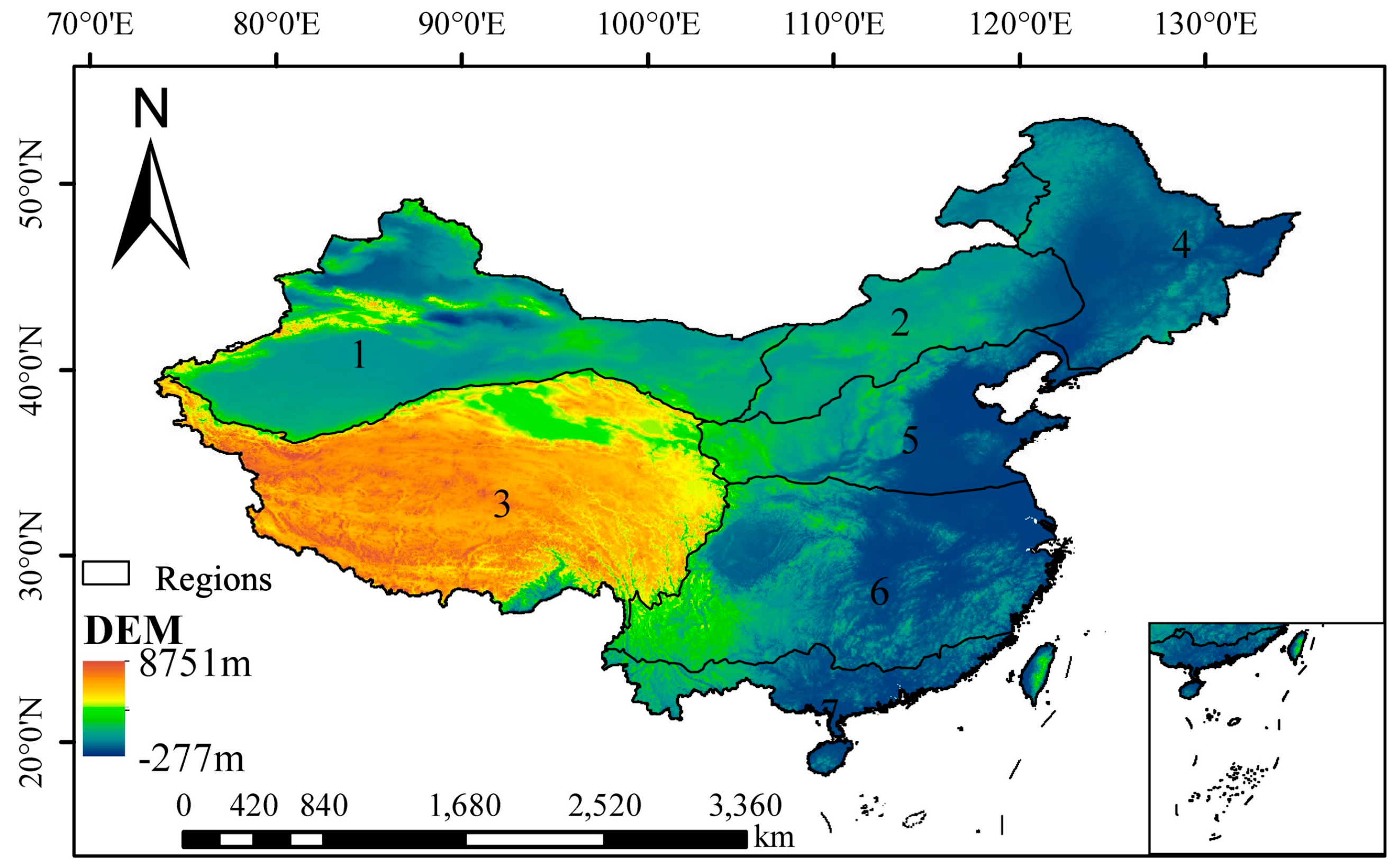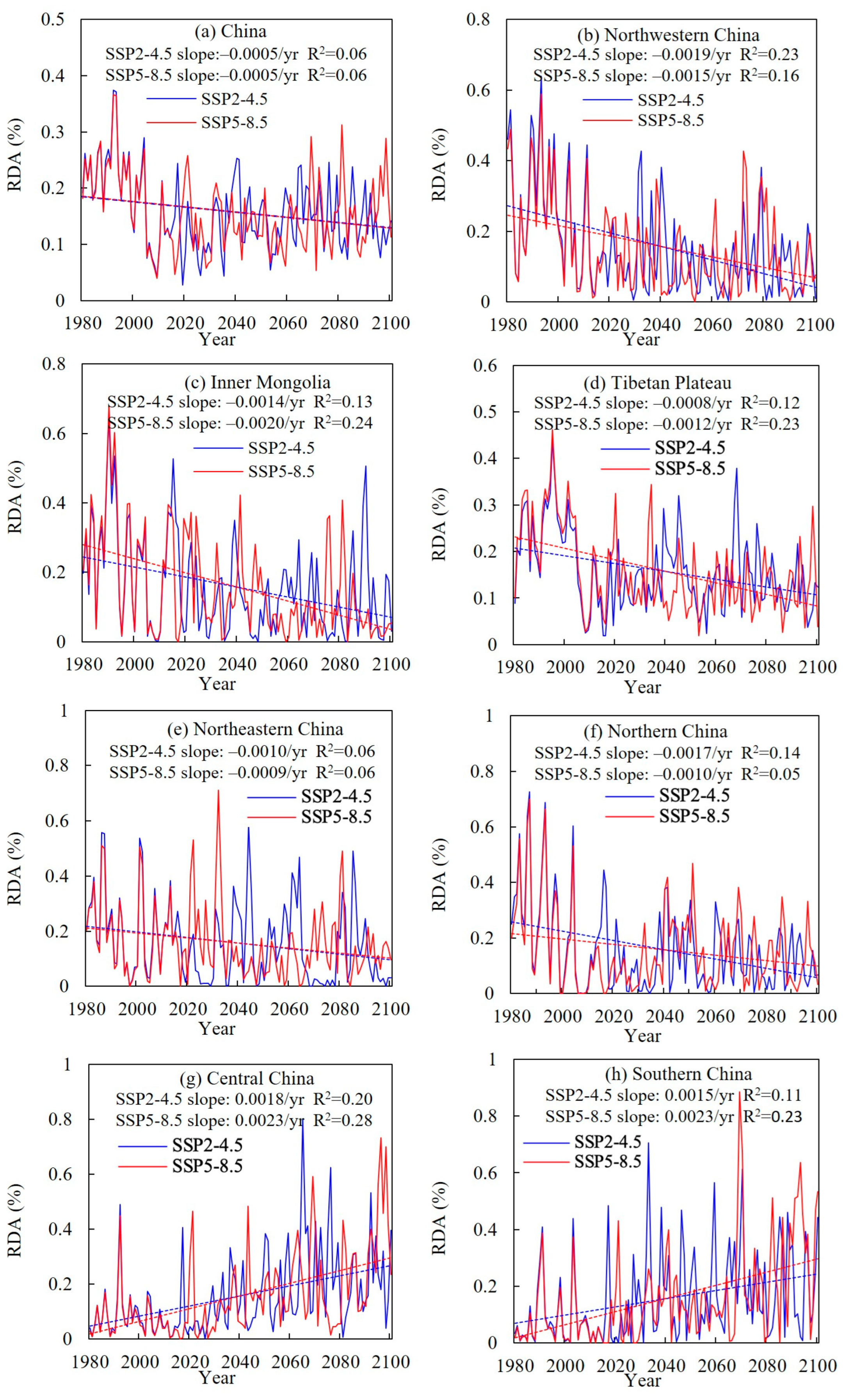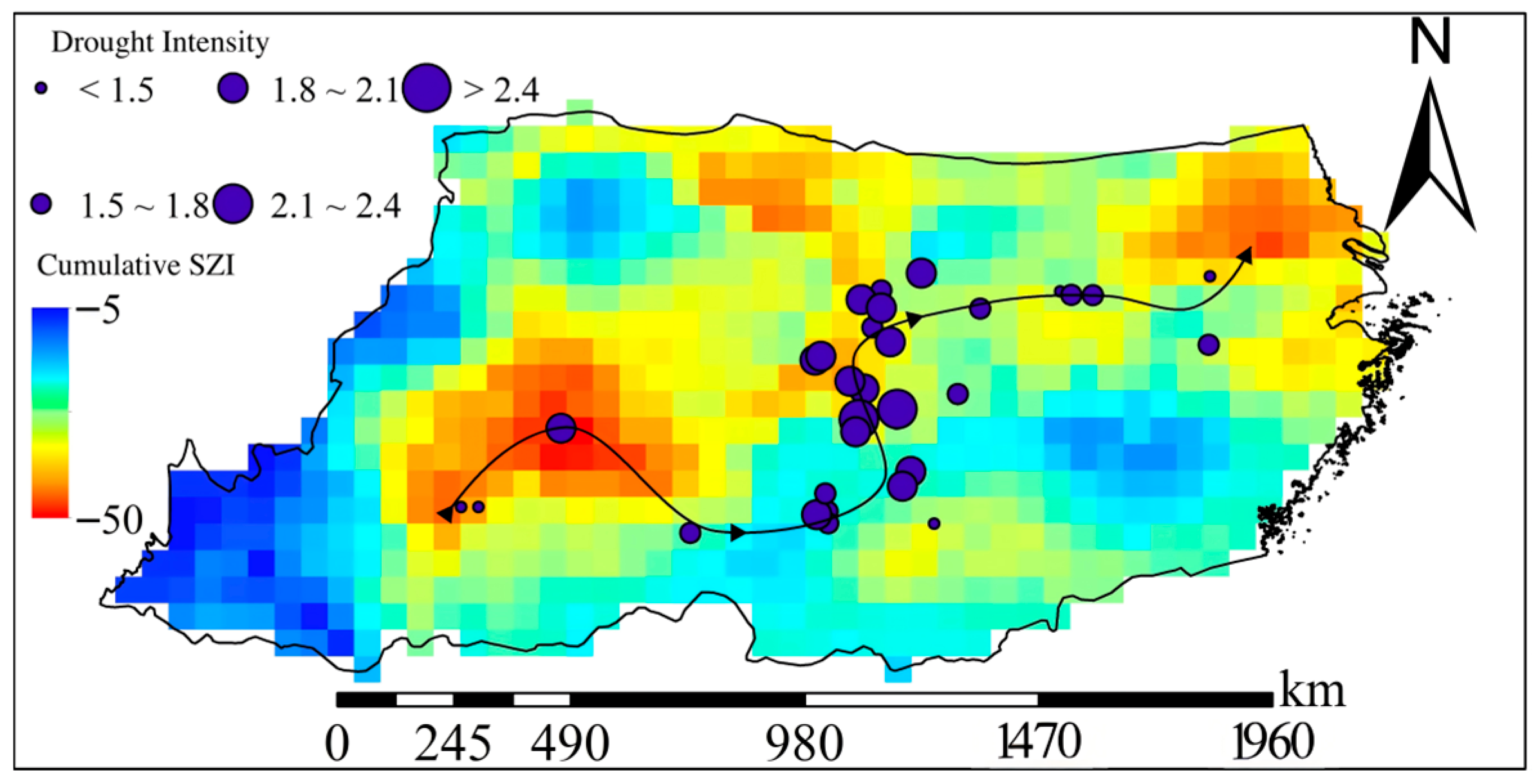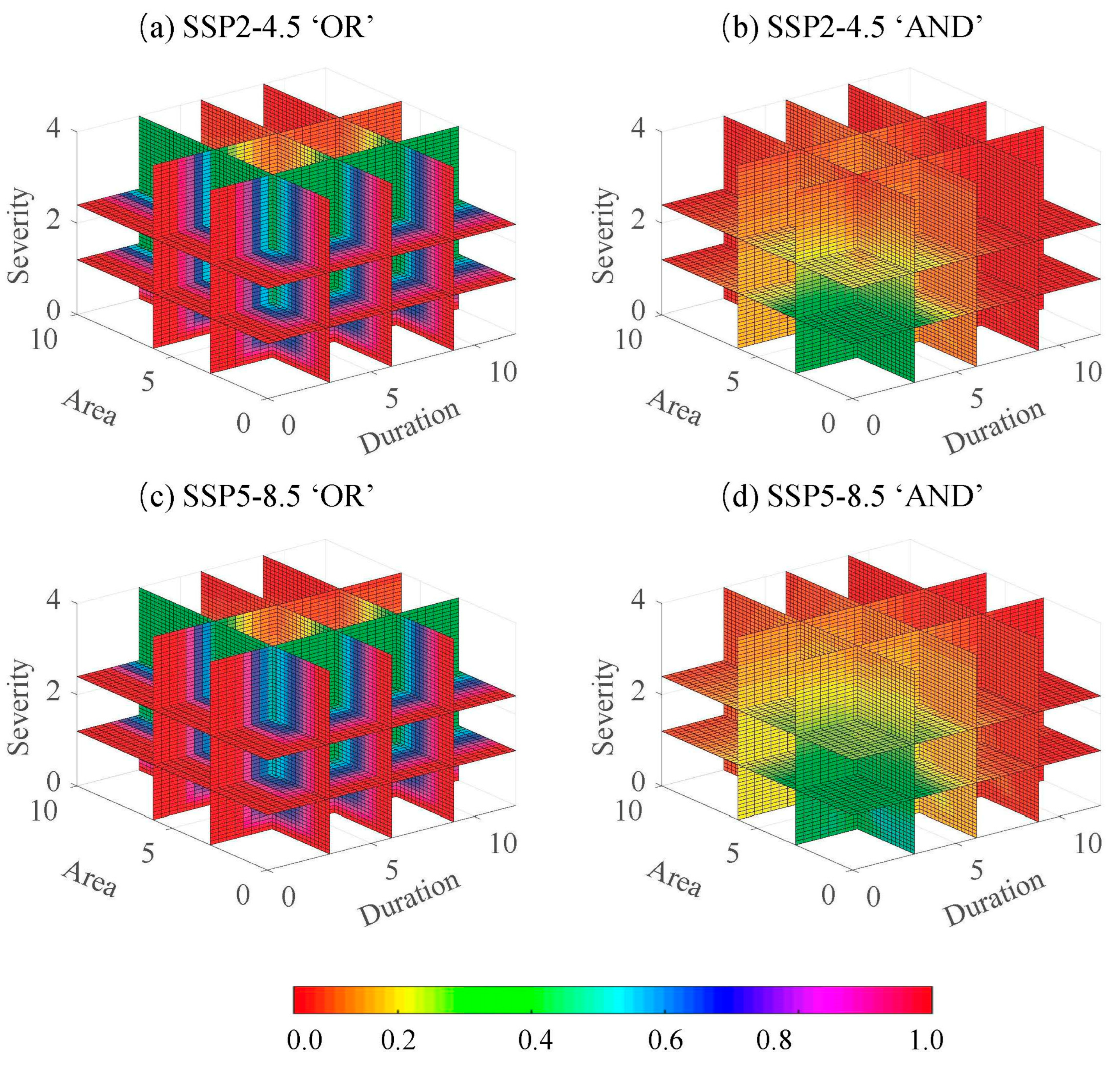Nonstationary Spatiotemporal Projection of Drought Across Seven Climate Regions of China in the 21st Century Based on a Novel Drought Index
Abstract
1. Introduction
2. Materials and Methods
2.1. Study Regions
2.2. Historical Data
2.3. Global Climate Model Data
2.4. Downscaling GCM Data
2.5. Drought Index Calculation
2.6. Three-Dimensional Drought Characteristic Identification
- (1)
- Delineation of drought patches. First, for each monthly 2D drought index grid, we identify cells below the drought threshold (SZI[CO2] < −1). Then, using a 3 × 3 neighborhood to group spatially adjacent drought cells, cells that are drought-affected in adjacent positions are grouped and assigned a common identifier, merged into a single drought patch (Figure 2). If a drought cell has no adjacent drought neighbors, assign a new identifier for a new patch; repeat until all cells for that month are processed. This yields multiple drought patches in different areas. Apply a given area threshold (A0) to screen patches: patches larger than A0 are defined as drought events (Figure 2, A1, A2, and A4), while patches smaller than A0 are discarded (Figure 2, A3 and A5). A0 is also used to determine temporal continuity between patches, preventing the merging of unrelated or weakly related drought events across adjacent months [34].
- (2)
- Temporal connection of drought patches. After identifying monthly drought patches, we need to determine whether patches in adjacent months are connected and can form a single drought event. Let a patch at time t have area At, the corresponding patch at t + 1 have area At+1, and their overlapping area be A*. If A* > A0, At and At+1 are considered temporally continuous and belong to the same drought event (A3 and A4); otherwise, they are treated as two independent drought events (A1 and A2) (Figure 3). Following this rule, evaluate the overlap A* between patches at successive times; when A* < A0, the drought event is deemed to have ended, and the patches identified as the same event are assigned the same identifier. Repeat this process to link all patches in time, producing 3D continuous drought bodies and yielding multiple 3D drought events.
2.7. Nonstationary Frequency Analysis
3. Results
3.1. Temporal Trends of SZI[CO2] in Different Regions of China
3.2. Spatiotemporal Dynamics of a Representative Future Drought Event
3.3. Frequency Analysis of Multiple Drought Characteristic Variables
4. Discussion
5. Conclusions
- (1)
- In Northwest China, Inner Mongolia, the Tibetan Plateau, Northeast China, and North China, the SZI[CO2] shows a significant increasing trend, while the affected drought area exhibits a decreasing trend, indicating a future wetting trend in these regions. Conversely, Central China and South China show signs of becoming drier, with increases in drought frequency, duration, and severity.
- (2)
- Drought characteristics (duration, area, severity) identified through the three-dimensional method display obvious trend components. A comparative analysis of seven stationary and nonstationary marginal distributions reveals that the nonstationary LON and GEV distributions are suitable for modeling the frequency distributions of drought features in most regions.
- (3)
- When the same values of drought features are considered, the joint occurrence probability of drought under SSP5-8.5 is higher than under SSP2-4.5. Regions with notable differences include the Tibetan Plateau, Central China, and South China. The conditional probability of drought occurrence considering three features is significantly higher than with only two features, indicating that ignoring any one drought characteristic is likely to lead to the underestimation of the probability of severe drought events.
Author Contributions
Funding
Data Availability Statement
Conflicts of Interest
Abbreviations
| AR6 | Sixth Assessment Report |
| IPCC | Intergovernmental Panel on Climate Change |
| CMIP5 | Coupled Model Intercomparison Project Phase 5 |
| CMIP6 | Coupled Model Intercomparison Project Phase 6 |
| GCMs | Global Climate Models |
| BCSD | Bias Correction and Spatial Downscaling |
| rs | Canopy Resistance Parameter |
| PM | Penman–Monteith |
| PET | Potential Evapotranspiration |
| SZI | Standardized Moisture Anomaly Index |
| SPEI | Standardized Precipitation–Evapotranspiration Index |
| scPDSI | Self-Calibrating Palmer Drought Severity Index |
| GAMLSS | Generalized Additive Models for Location, Scale, and Shape |
| NO | Normal |
| LNO | Log-Normal |
| GAM | Gamma |
| WB | Weibull |
| EXP | Exponential |
| LOG | Log-Logistic |
| GEV | Generalized Extreme Value |
| RDA | Relative Drought Area |
References
- Zhang, B.; Kouchak, A.A.; Yang, Y.; Wei, J.; Wang, G. A water-energy balance approach for multi-category drought assessment across globally diverse hydrological basins. Agric. For. Meteorol. 2019, 264, 247–265. [Google Scholar] [CrossRef]
- Bai, Y.; Li, S. Growth peak of vegetation and its response to drought on the Mongolian Plateau. Ecol. Indic. 2022, 141, 109150. [Google Scholar] [CrossRef]
- Zhang, Z.; Ju, W.; Zhou, Y.; Li, X. Revisiting the cumulative effects of drought on global gross primary productivity based on new long-term series data (1982–2018). Glob. Change Biol. 2022, 28, 3620–3635. [Google Scholar] [CrossRef]
- Zhao, M.; Running, S.W. Drought-induced reduction in global terrestrial net primary production from 2000 through 2009. Science 2010, 329, 940–943. [Google Scholar] [CrossRef] [PubMed]
- Ledger, M.E.; Brown, L.E.; Edwards, F.K.; Milner, A.M.; Woodward, G. Drought alters the structure and functioning of complex food webs. Nat. Clim. Change 2013, 3, 223–227. [Google Scholar] [CrossRef]
- Wegren, S.K. Food security and Russia’s 2010 drought. Eurasian Geogr. Econ. 2013, 52, 140–156. [Google Scholar] [CrossRef]
- Dutra, E.; Di Giuseppe, F.; Wetterhall, F.; Pappenberger, F. Seasonal forecasts of droughts in African basins using the Standardized Precipitation Index. Hydrol. Earth Syst. Sci. 2013, 17, 2359–2373. [Google Scholar] [CrossRef]
- Liu, Z.; Zhou, W. The 2019 autumn hot drought over the middle-lower Reaches of the Yangtze River in China: Early propagation, process evolution, and concurrence. J. Geophys. Res. Atmos. 2021, 126, e2020JD033742. [Google Scholar] [CrossRef]
- Feng, A.; Chao, Q.; Liu, L.; Gao, G.; Wang, G.; Zhang, X.; Wang, Q. Will the 2022 compound heatwave–drought extreme over the Yangtze River Basin become Grey Rhino in the future? Adv. Clim. Change Res. 2024, 15, 547–556. [Google Scholar] [CrossRef]
- Liu, Y.; Zhang, Y.; Peñuelas, J.; Kannenberg, S.A.; Gong, H.; Yuan, W.; Wu, C.; Zhou, S.; Piao, S. Drought legacies delay spring green-up in northern ecosystems. Nat. Clim. Change 2025, 15, 444–451. [Google Scholar] [CrossRef]
- Zhang, B.; Xia, Y.; Huning, L.S.; Wei, J.; Wang, G.; AghaKouchak, A. A framework for global multicategory and multiscalar drought characterization accounting for snow processes. Water Resour. Res. 2019, 55, 9258–9278. [Google Scholar] [CrossRef]
- Gebrechorkos, S.H.; Sheffield, J.; Vicente-Serrano, S.M.; Funk, C.; Miralles, D.G.; Peng, J.; Dyer, E.; Talib, J.; Beck, H.E.; Singer, M.B.; et al. Warming accelerates global drought severity. Nature 2025, 642, 628–635. [Google Scholar] [CrossRef] [PubMed]
- Khosravi, Y.; Ouarda, T.B.M.J. Drought risks are projected to increase in the future in central and southern regions of the Middle East. Commun. Earth Environ. 2025, 6, 384. [Google Scholar] [CrossRef]
- Ukkola, A.M.; De Kauwe, M.G.; Roderick, M.L.; Abramowitz, G.; Pitman, A.J. Robust future changes in meteorological drought in CMIP6 projections despite uncertainty in precipitation. Geophys. Res. Lett. 2020, 47, e2020GL087820. [Google Scholar] [CrossRef]
- Cook, B.I.; Mankin, J.S.; Marvel, K.; Williams, A.P.; Smerdon, J.E.; Anchukaitis, K.J. Twenty-first century drought projections in the CMIP6 forcing scenarios. Earth’s Future 2020, 8, e2019EF001461. [Google Scholar] [CrossRef]
- Bedia, J.; Baño-Medina, J.; Legasa, M.N.; Iturbide, M.; Manzanas, R.; Herrera, S.; Casanueva, A.; San-Martín, D.; Cofiño, A.S.; Gutiérrez, J.M. Statistical downscaling with the downscaleR package (v3.1.0): Contribution to the VALUE intercomparison experiment. Geosci. Model Dev. 2020, 13, 1711–1735. [Google Scholar] [CrossRef]
- Yang, Y.; Tang, J.; Xiong, Z.; Wang, S.; Yuan, J. An intercomparison of multiple statistical downscaling methods for daily precipitation and temperature over China: Present climate evaluations. Clim. Dyn. 2019, 53, 4629–4649. [Google Scholar] [CrossRef]
- Ahmed, K.F.; Wang, G.; Silander, J.; Wilson, A.M.; Allen, J.M.; Horton, R.; Anyah, R. Statistical downscaling and bias correction of climate model outputs for climate change impact assessment in the U.S. northeast. Glob. Planet. Change 2013, 100, 320–332. [Google Scholar] [CrossRef]
- Zhang, G.; Su, X.; Singh, V.P.; Ayantobo, O.O. Appraising standardized moisture anomaly index (SZI) in drought projection across China under CMIP6 forcing scenarios. J. Hydrol. Reg. Stud. 2021, 37, 100898. [Google Scholar] [CrossRef]
- Yang, Y.; Roderick, M.L.; Zhang, S.; McVicar, T.R.; Donohue, R.J. Hydrologic implications of vegetation response to elevated CO2 in climate projections. Nat. Clim. Change 2019, 9, 44–48. [Google Scholar] [CrossRef]
- Sheffield, J.; Wood, E.F.; Roderick, M.L. Little change in global drought over the past 60 years. Nature 2012, 491, 435–438. [Google Scholar] [CrossRef]
- Xu, K.; Yang, D.; Yang, H.; Li, Z.; Qin, Y.; Shen, Y. Spatio-temporal variation of drought in China during 1961–2012: A climatic perspective. J. Hydrol. 2015, 526, 253–264. [Google Scholar] [CrossRef]
- Xu, K.; Yang, D.; Xu, X.; Lei, H. Copula based drought frequency analysis considering the spatio-temporal variability in Southwest China. J. Hydrol. 2015, 527, 630–640. [Google Scholar] [CrossRef]
- Mahdizadeh, J.; Ghavidel, Y.; Farajzadeh, M. High-resolution spatiotemporal analysis of drought dynamics in Iran. Environ. Monit. Assess. 2025, 197, 1005. [Google Scholar] [CrossRef]
- Zhou, Z.; Wang, P.; Li, L.; Fu, Q.; Ding, Y.; Chen, P.; Xue, P.; Wang, T.; Shi, H. Recent development on drought propagation: A comprehensive review. J. Hydrol. 2024, 645, 132196. [Google Scholar] [CrossRef]
- Ryan, O.; Haslbeck, J.M.B.; Waldorp, L.J. Non-stationarity in time-series analysis: Modeling stochastic and deterministic trends. Multivar. Behav. Res. 2025, 60, 556–588. [Google Scholar] [CrossRef] [PubMed]
- Wu, J.; Gao, X. A gridded daily observation dataset over China region and comparison with the other datasets. Chin. J. Geophys. 2013, 56, 1102–1111. [Google Scholar] [CrossRef]
- Wu, J.; Gao, X.; Giorgi, F.; Chen, D. Changes of effective temperature and cold/hot days in late decades over China based on a high resolution gridded observation dataset. Int. J. Climatol. 2017, 37, 788–800. [Google Scholar] [CrossRef]
- Xu, Y.; Gao, X.; Shen, Y.; Xu, C.; Shi, Y.; Giorgi, F. A daily temperature dataset over China and its application in validating a RCM simulation. Adv. Atmos. Sci. 2009, 26, 763–772. [Google Scholar] [CrossRef]
- Wood, A.W.; Leung, L.R.; Sridhar, V.; Lettenmaier, D.P. Hydrologic implications of dynamical and statistical approaches to downscaling climate model outputs. Clim. Change 2004, 62, 189–216. [Google Scholar] [CrossRef]
- Michalek, A.T.; Villarini, G.; Kim, T. Understanding the impact of precipitation bias-correction and statistical downscaling methods on projected changes in flood extremes. Earth’s Future 2024, 12, e2023EF004179. [Google Scholar] [CrossRef]
- Andreadis, K.M.; Clark, E.A.; Wood, A.W.; Hamlet, A.F.; Lettenmaier, D.P. Twentieth-century drought in the conterminous United States. J. Hydrometeorol. 2005, 6, 985–1001. [Google Scholar] [CrossRef]
- Feng, K.; Su, X.; Singh, V.P.; Ayantobo, O.O.; Zhang, G.; Wu, H.; Zhang, Z. Dynamic evolution and frequency analysis of hydrological drought from a three-dimensional perspective. J. Hydrol. 2021, 600, 126675. [Google Scholar] [CrossRef]
- Sheffield, J.; Andreadis, K.M.; Wood, E.F.; Lettenmaier, D.P. Global and continental drought in the second half of the twentieth century: Severity–area–duration analysis and temporal variability of large-scale events. J. Clim. 2009, 22, 1962–1981. [Google Scholar] [CrossRef]
- Rigby, R.A.; Stasinopoulos, D.M. Generalized additive models for location, scale and shape. J. R. Stat. Soc. Ser. C (Appl. Stat.) 2005, 54, 507–554. [Google Scholar] [CrossRef]
- Aas, K.; Czado, C.; Frigessi, A.; Bakken, H. Pair-copula constructions of multiple dependence. Insur. Math. Econ. 2009, 44, 182–198. [Google Scholar] [CrossRef]
- Das, J.; Jha, S.; Goyal, M.K. Non-stationary and copula-based approach to assess the drought characteristics encompassing climate indices over the Himalayan states in India. J. Hydrol. 2020, 580, 124356. [Google Scholar] [CrossRef]
- Hobæk Haff, I.; Aas, K.; Frigessi, A. On the simplified pair-copula construction—Simply useful or too simplistic? J. Multivar. Anal. 2010, 101, 1296–1310. [Google Scholar] [CrossRef]
- Yu, X.; Zeng, X.; Brocca, L.; Gui, D.; Wang, D.; Wu, J. A Copula-based composite drought index for enhanced drought monitoring and analysis. J. Geophys. Res. Atmos. 2025, 130, e2024JD041867. [Google Scholar] [CrossRef]
- Li, Z.; Sun, F.; Wang, H.; Wang, T. Declining contribution of plant physiological effects to global drought characteristics with rising CO2 using state-of-the-art earth system models. Earth’s Future 2025, 13, e2024EF005548. [Google Scholar] [CrossRef]
- Li, X.; Kang, S.; Niu, J.; Huo, Z.; Liu, J. Improving the representation of stomatal responses to CO2 within the Penman–Monteith model to better estimate evapotranspiration responses to climate change. J. Hydrol. 2019, 572, 692–705. [Google Scholar] [CrossRef]
- Manzoni, S.; Fatichi, S.; Feng, X.; Katul, G.G.; Way, D.; Vico, G. Consistent responses of vegetation gas exchange to elevated atmospheric CO2 emerge from heuristic and optimization models. Biogeosciences 2022, 19, 4387–4414. [Google Scholar] [CrossRef]
- Engineer, C.B.; Hashimoto-Sugimoto, M.; Negi, J.; Israelsson-Nordström, M.; Azoulay-Shemer, T.; Rappel, W.-J.; Iba, K.; Schroeder, J.I. CO2 sensing and CO2 regulation of stomatal conductance: Advances and open questions. Trends Plant Sci. 2016, 21, 16–30. [Google Scholar] [CrossRef]
- Xu, F.; Qu, Y.; Bento, V.A.; Song, H.; Qiu, J.; Qi, J.; Wan, L.; Zhang, R.; Miao, L.; Zhang, X.; et al. Understanding climate change impacts on drought in China over the 21st century: A multi-model assessment from CMIP6. npj Clim. Atmos. Sci. 2024, 7, 32. [Google Scholar] [CrossRef]
- Hao, X.; Zhang, S.; Li, W.; Duan, W.; Fang, G.; Zhang, Y.; Guo, B. The uncertainty of Penman-Monteith method and the energy balance closure problem. J. Geophys. Res. Atmos. 2018, 123, 7433–7443. [Google Scholar] [CrossRef]
- Acharki, S.; Raza, A.; Vishwakarma, D.K.; Amharref, M.; Bernoussi, A.S.; Singh, S.K.; Al-Ansari, N.; Dewidar, A.Z.; Al-Othman, A.A.; Mattar, M.A. Comparative assessment of empirical and hybrid machine learning models for estimating daily reference evapotranspiration in sub-humid and semi-arid climates. Sci. Rep. 2025, 15, 2542. [Google Scholar] [CrossRef]
- Su, B.; Huang, J.; Mondal, S.K.; Zhai, J.; Wang, Y.; Wen, S.; Gao, M.; Lv, Y.; Jiang, S.; Jiang, T.; et al. Insight from CMIP6 SSP-RCP scenarios for future drought characteristics in China. Atmos. Res. 2021, 250, 105375. [Google Scholar] [CrossRef]
- Yao, N.; Li, L.; Feng, P.; Feng, H.; Li Liu, D.; Liu, Y.; Jiang, K.; Hu, X.; Li, Y. Projections of drought characteristics in China based on a standardized precipitation and evapotranspiration index and multiple GCMs. Sci. Total Environ. 2020, 704, 135245. [Google Scholar] [CrossRef]
- Wang, Q.; Zhai, P.; Qin, D. New perspectives on ‘warming–wetting’ trend in Xinjiang, China. Adv. Clim. Change Res. 2020, 11, 252–260. [Google Scholar] [CrossRef]
- Li, B.; Liu, D.; Yu, E.; Wang, L. Warming-and-wetting trend over the China’s drylands: Observational evidence and future projection. Glob. Environ. Change 2024, 86, 102826. [Google Scholar] [CrossRef]
- Slater, L.J.; Anderson, B.; Buechel, M.; Dadson, S.; Han, S.; Harrigan, S.; Kelder, T.; Kowal, K.; Lees, T.; Matthews, T.; et al. Nonstationary weather and water extremes: A review of methods for their detection, attribution, and management. Hydrol. Earth Syst. Sci. 2021, 25, 3897–3935. [Google Scholar] [CrossRef]
- Mesbahzadeh, T.; Mirakbari, M.; Mohseni Saravi, M.; Soleimani Sardoo, F.; Miglietta, M.M. Meteorological drought analysis using copula theory and drought indicators under climate change scenarios (RCP). Meteorol. Appl. 2020, 27, e1856. [Google Scholar] [CrossRef]
- Wang, F.; Wang, Z.; Yang, H.; Zhao, Y.; Zhang, Z.; Li, Z.; Hussain, Z. Copula-based drought analysis using standardized precipitation evapotranspiration index: A case study in the Yellow River Basin, China. Water 2019, 11, 1298. [Google Scholar] [CrossRef]
- Zhang, B.; Wang, S.; Moradkhani, H.; Slater, L.; Liu, J. A vine copula-based ensemble projection of precipitation intensity-duration-frequency curves at sub-daily to multi-day time scales. Water Resour. Res. 2022, 58, e2022WR032658. [Google Scholar] [CrossRef]









| CMIP6 | Country | Resolution (Lat/Lon°) |
|---|---|---|
| ACCESS-ESM-1-5 | Australia | 1.3 × 1.9 |
| BCC-CSM2-MR | China | 2.8 × 2.8 |
| CESM2 | America | 0.9 × 1.3 |
| EC-EARTH3 | Europe | 1.1 × 1.1 |
| GFDL-ESM4 | America | 2.0 × 2.5 |
| HadGEM3-GC31-LL | United Kingdom | 1.3 × 1.9 |
| MIROC6 | Japan | 1.4 × 1.4 |
| MPI-ESM1-2-HR | Germany | 1.9 × 1.9 |
| MRI-ESM2-0 | Japan | 1.1 × 1.1 |
| NorESM2-MM | Norway | 1.9 × 2.5 |
Disclaimer/Publisher’s Note: The statements, opinions and data contained in all publications are solely those of the individual author(s) and contributor(s) and not of MDPI and/or the editor(s). MDPI and/or the editor(s) disclaim responsibility for any injury to people or property resulting from any ideas, methods, instructions or products referred to in the content. |
© 2025 by the authors. Licensee MDPI, Basel, Switzerland. This article is an open access article distributed under the terms and conditions of the Creative Commons Attribution (CC BY) license (https://creativecommons.org/licenses/by/4.0/).
Share and Cite
Yan, Z.; Zhang, G.; Wang, H.; Zhao, B. Nonstationary Spatiotemporal Projection of Drought Across Seven Climate Regions of China in the 21st Century Based on a Novel Drought Index. Water 2025, 17, 3206. https://doi.org/10.3390/w17223206
Yan Z, Zhang G, Wang H, Zhao B. Nonstationary Spatiotemporal Projection of Drought Across Seven Climate Regions of China in the 21st Century Based on a Novel Drought Index. Water. 2025; 17(22):3206. https://doi.org/10.3390/w17223206
Chicago/Turabian StyleYan, Zhijie, Gengxi Zhang, Huimin Wang, and Baojun Zhao. 2025. "Nonstationary Spatiotemporal Projection of Drought Across Seven Climate Regions of China in the 21st Century Based on a Novel Drought Index" Water 17, no. 22: 3206. https://doi.org/10.3390/w17223206
APA StyleYan, Z., Zhang, G., Wang, H., & Zhao, B. (2025). Nonstationary Spatiotemporal Projection of Drought Across Seven Climate Regions of China in the 21st Century Based on a Novel Drought Index. Water, 17(22), 3206. https://doi.org/10.3390/w17223206






